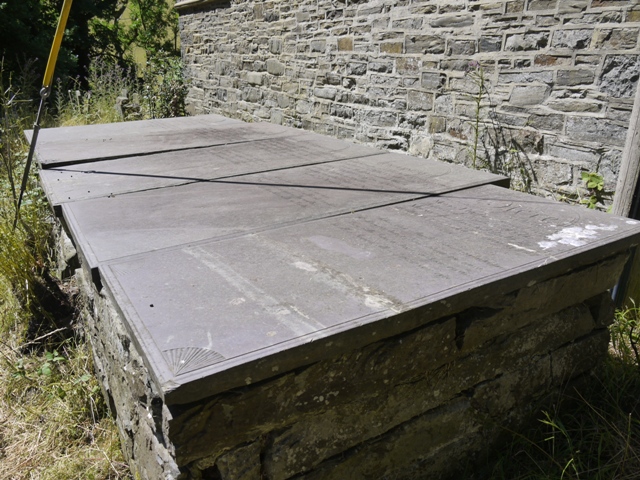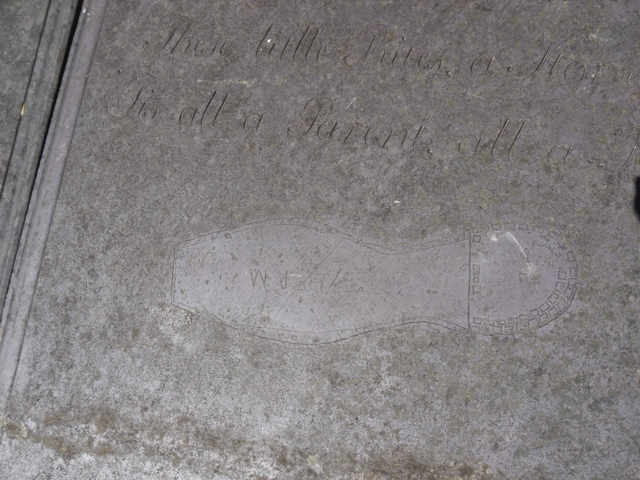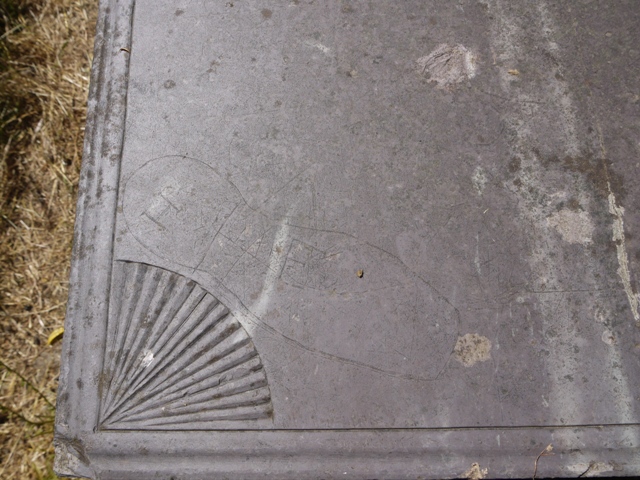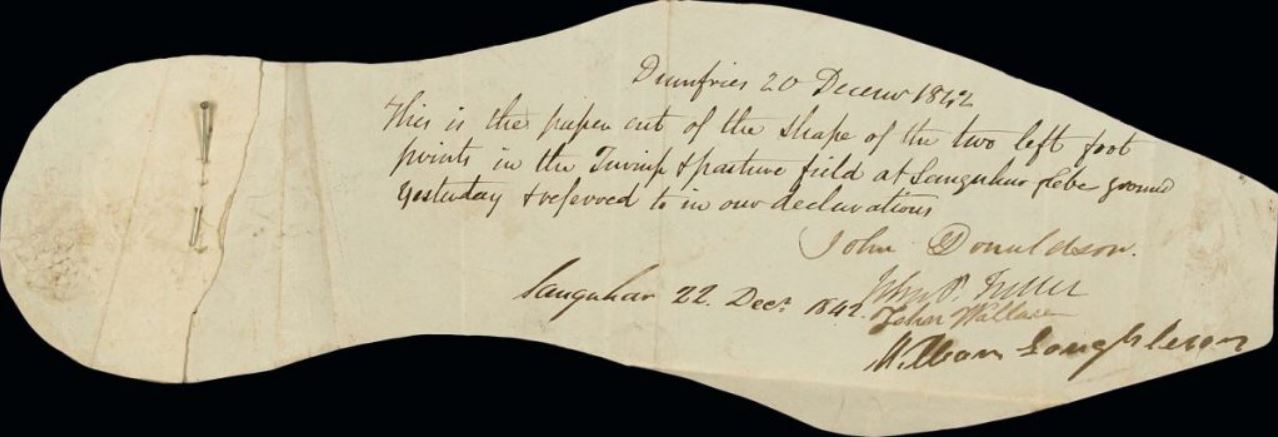At the east end of Llanychaiarn Church is a rank of five chest tombs, to members of the Hughes family of Aberllolwyn and of Morfa, in the Parish of Llanychaiarn, ( Morfa Bychan as we now know it) The five slate stabs adjoin one another like tabletops. Together they tell the story of a couple of generations. But the right hand slab is remarkable for a rare piece of naive artwork, the meaning of which intrigues me.

Graves of members of the Hughes family of Aberlllolwyn and Morva at the east end of Llanychaiarn Church
The slab reads ‘ Here lies the interred body of Anna Maria Hughes, second daughter of John and Elizabeth Hughes of Morfa, who departed this life the 24th of March 1777 in the 16th year of her life’. Her epitaph reads:
Adieu blest maid, Return again to Dust,
The’ Almighty bids to him submit we must
These little Rites a Stone, a Verse receive
Tis all a parent, all a friend can give.
Hers was the first of the five burials. Next to her are the graves of her mother Elizabeth Hughes, her father John Hughes of Morva, her sister Elinor ( 1764-1845) and her uncle Erasmus Hughes, her mother’s brother. It was Erasmus who occupied Aberllolwyn and died there, a bachelor aged 73 in 1803. As his epitaph points out he spent his life much preoccupied with the hereafter.
His life was spent in meditation on the Holy Scriptures and resigned in the hope of Resurrection to immortal Glory through the Merits of his Redeemer whoom( sic) he steadfastly trusted.
What is remarkable is that in addition to the copperplate verse engraved on Anna Maria’s slab is a remarkable bit of graffiti, the outline of not one, but two footprints, in neat square-toed shoes. The individual square headed nails securing the heel are each carefully inscribed. The positioning of the two footprints is informal, contrasting with the neat symmetry of the ornament and inscriptions. I don’t believe they were done in the mason’s yard.

Footprint on the grave of Anna Maria Hughes who died in 1777

A second and different footprint at the foot of the grave
Who carved them upon young Anna Maria’s grave? And why? or when?
The other day I came across a very similar footprint, drawn on paper, in 1824. This was an example of a forensic drawing of footmarks at a crime scene:

A paper cut made in 1842 of left footprints in a turnip field at Sanquhar, Dumfries and Galloway
The shoe seems of a very similar style. What were shoes like in 1777? or was this carving added 50 years after her death?
I would love to hear of any other examples of footprint graffiti similar to this.
The full text of the other four graves is as follows:
1. Sacred to the Memory of Erasmus Hughes late of Aberllolwyn Esq., who died 13 March 1803 aged 73 years. His inscription reads: His life was spent in meditation on the Holy Scriptures and resigned in the hope of Resurrection to immortal Glory through the Merits of his Redeemer whoom( sic) he steadfastly trusted.
2. Sacred to the Memory of Elinor Hughes, daughter of John Hughes Esquire late of Morfa in the Parish of Llanychaiarn who departed this life 28th of January 1845 aged 81 years
3. Underneath lie the remains of John Hughes Esq late of Morfa second son of John Hughes Esq of Hendrevelen who exchanged this life for a Blessed Eternity the 27th day of October1806 in the 80th Year of his age. His epitaph reads:
Just upright merciful in all thy ways
In Christian meekness spending here thy days
Sweet sleep in Jesus thou dost now enjoy
Partaking happiness without alloy
4. Underneath lie the remains of Elizabeth second daughter of Thomas Hughes Esq late of Aberllolwne and wife of John Hughes Esq, of Morva both of this Parish who resigned her Soul to the Almighty giver the 12th day of November 1807 in the 71st year of her life. Her epitaph reads:
Adieu and long adieu thou ever dear
Thou best of Parents and thou Friend sincere
May thy survivors imitate thy worth
And live to God as thou didst while on earth
They are an evocative series of memorials: Erasmus Hughes was the only son of Thomas Hughes and Elizabeth Lloyd. One of his sisters Mary, married Edward Hughes of Dyffryn-gwyn, Merioneth and another, Elizabeth, married John Hughes of Morva. On Erasmus’ death the Aberllolwyn estate passed first to his sister Mary Hughes, and then to his niece Elizabeth Jane, another of John and Elizabeth Hughes’ daughters. It is noteworthy that all these Hugheses seem to have married men already bearing the name Hughes.

Ah, Ceredigion cemeteries:
http://rogerdboyle.blogspot.com/2013/10/what-time.html
Have you seen the gravestone from the time of Elizabeth 1st ,at the back of the church.
On a raised grave by the church door in Dolgellau are lots of children’s handprints of varying sizes.
My thought is that it could be of the descendants of those buried who were emigrating, It is fascinating though, I’m glad I saw this post.
There are several examples of Victorian(?) lifesize handprints around the top of the front boundary wall of the Quarry Hospital in Llanberis, Gwynedd. But I don’t believe I’ve ever seen a footprint before. The slate lends itself so well to informal carving, doesn’t it?
There is a child-sized shoe outline (also with “shoe nails” in the heel) on a gravestone now lying on its back, from memory just east of the Glastonbury thorn in Llanbadarn churchyard, Aberystwyth.
Thanks! I’ll have a look for it. It will be interesting to see the name and date on the slab.
This was covered in the Folklore Society journal quite a few years ago – too long ago for me to remember much about it. I wrote and told them about tiny footprint shapes I had seen on a roof at Coughlan Court.
Thanks I will try and find this article!
It may have been in the newsletter rather than the journal.
I’ve just attended a talk given by Tom Lerwill in Oswestry (12 oct. 2018) concerning such footprints on slate tombs in north east Wales. No definate explanation can be given, but they appear from as early as the 1730’s through to the 1860’s when they abrubtly finish. Found on slate table and ledger slabs in areas that produced good quality slate. None recorded further east into England, or on other types of stone, apart from one on a sandstone grave. Most appear to have no direct connection with the deceased, but are allowed to remain, so presume were accepted by all as some form of commemoration, record or social act, only being banned as the church authorities clamped down for some reason.
The style faithfully reproduces those of the day, the sole being shown, only one recorded find of a shoe shown in profile. Minature shoes also occur as do other graffiti, chiefly gaming boards and hands! But, still no real explanation. Tom’s survey was carried out some 25 years ago, since when many of those recorded have either been lost to vegetation or weathering, which prompts me to suggest that you record any you find and pass that information on your local History Society or archaeological officer.
How interesting! I don’t know about Tom Lerwill ( I can find an athlete of that name on google) is his work published anywhere? Or could I contact him through the organisation to which he spoke in Oswestry?
There are several footprints on gravestones at Repton, and have today seen some on an altar tomb at Wymondham, Leicestershire. ( It was whilst googling why this was that i came across your post).
Years ago Tom Lerwill and I surveyed all the graveyards in the Tanat Valley and surrounding areas for the graffitti which were the subject of his talk. They were mostly footprints, with some handprints, and square patterns we think were for playing nine mens morris. Further afield, on Angelsey and the Llwyn, there are frequently ships and I recall finding a horse once.
I was therefor delighted to learn of this post, and stopped at Llanychaiarn when passing recently, where we found a total of eight footprints, some of them quite faint. Their visibility depends greatly on light conditions, and can be enhanced by wetting, but still difficult to photogragh succesfully.
We also looked at some other churchyards last week and mostly drew a blank, but at Llansantffraid (next to Llanon), there are some nice sailing ships.
Bridge parapets are often worth looking at, presumably because they are natural places to hang around and waste time. For example, there are some ships and a plane among all the initials and love-hearts on the parapet approaching Cardigan bridge, in the shadow of the castle.
A couple of other locations I know of are Pont Ogwen (south of Bethesda) where the slate parapets are covered in a bizarre variety of drawings, and Maesbury Marsh canal bridge (south of Oswestry) where there are some footprints and a large fish on the parapet.
I’d always be interested to hear of other examples!
I wouldn’t want to speculate on the purpose of such graffitti, but Tom gave some very interesting suggestions in his talk.
Great to hear from you! I was in touch with Tom and he sent me some of your and his summary findings early last year. You’ve done such good recording it would be great if you publish it in a local history journal. I recently saw some very nice ship graffiti in Tywyn graveyard.
Following on from your observations as regards sailing ship carvings, three immediately spring to mind. A good example is to be seen on the parapet of the bridge in the grounds of Invarary Castle, Argyle (see my Flickr page on Invarary), another in the entrance to Ossian’s Cave on the coastal walk round North Arran, Isle of Arran, Scotland and the third, carved into the entrance to the limestone of Whinspit Caves, Dorset, (limestone mines and quarries). All appear to be contemporary with their locations i.e. 18/19th century and reflect the sailing ships employed in the area at the time. I’ve seen and discovered many more on my travels and during my work as a Heritage Consultant, they represent a fascinating aspect of our past.
I’m sorry, but I thought I was replying to a comment made on your blog concerning ship carvings. Yours confused, Clive Bowd.
I think you have!
Footprints .. I know of one on a tabletop tomb in Overbury churchyard, Worcs. (pointed toe, star pattern in heel)dated 1741 or 1747, initalled TA) Also a footprint on the wall of Foxcote House, Foxcote, Glos. (squared toe, hobnails in heel, poss worn initials on sole) Both are really shoe outlines rather than footprints
It’s becoming obvious from the number of reports of such findings that shoe prints on tombs are to found around Britain, not confined to any specific area. No doubt certain areas will prove more prolific, but only an in-depth survey of Britain will supply the answer to this. I’ve looked for a photograph of the specimen in Overbury but cannot find one. Perhaps you are able to supply one as the star design is of added interest as it might relate to such designs on lead tokens and buttons of the period.
Sorry I’ve only just noticed this comment and approved it. I think it is really directed at the previous writer Gilbert Stirling Lee. If you would like me to forward it to him let me know by email.
Yes, please send my comments to Gilbert Stirling, the star design might prove very informative.
Thank you.
Clive Bowd.
I’ve emailed him and sent him your email.
Good afternoon,
I am a member of Coedpoeth Historical Society and am trying to find contact details for Mr Tom Lerwill. I think his talk would be of interest to our members. Are you able to help please.
Many thanks
Gillian Jones
gilliankirbyjones@gmail.com
I’ve emailed you.
I’m a volunteer at Cefn Mawr Museum and History Society and I;ve been trying to find contact details for Tom Lerwell as his talk sounds interesting.
Could you help please??
Many thanks.
Laura Davies
lauradavies3802@btinternet.com
Hi, I do have an email though I’ve not been in contact with him since 2019. However it would not be right to publish this on my blog, so you would need to email me.